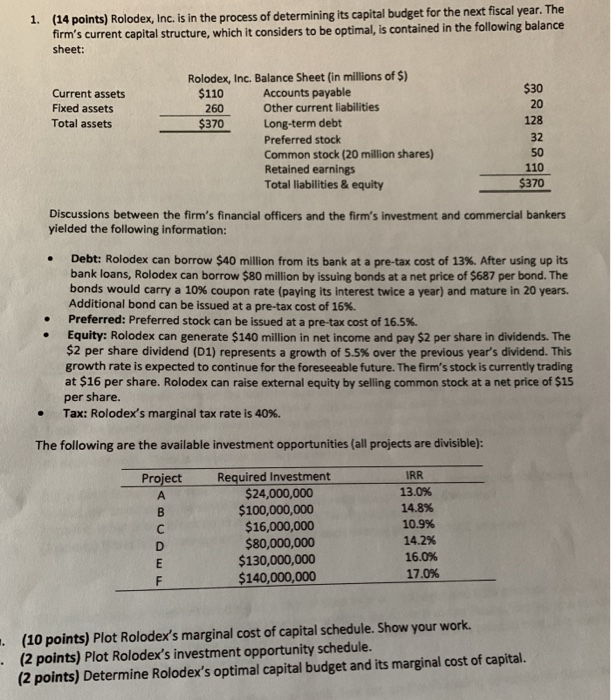
(14 points) Rolodex, Inc. is in the process of determining its capital budget for the next fiscal year. The firm' sheet: 1. s current capital structure, which it considers to be optimal, is contained in the following balance Rolodex, Inc. Balance Sheet (in millions of $ $30 20 128 32 50 110 $370 Accounts payable Current assets Fixed assets Total assets 260Other current liabilities $370 Long-term debt Preferred stock Common stock (20 million shares) Retained earnings Total liabilities & equity Discussions between the firm's financial officers and the firm's investment and commercial bankers yielded the following information: Debt: Rolodex can borrow $40 million from its bank at a pre-tax cost of 13%. After using up its bank loans, Rolodex can borrow $80 million by issuing bonds at a net price of $687 per bond. The bonds would carry a 10% coupon rate (paying its interest twice a year) and mature in 20 years. Additional bond can be issued at a pre-tax cost of 16%. Preferred: Preferred stock can be issued at a pre-tax cost of 16.5%. Equity: Rolodex can generate $140 million in net income and pay $2 per share in dividends. The $2 per share dividend (DI) represents a growth of 5.5% over the previous year's dividend. This growth rate is expected to continue for the foreseeable future. The firm's stock is currently trading at $16 per share. Rolodex can raise external equity by selling common stock at a net price of $15 per share. Tax: Rolodex's marginal tax rate is 40%. The following are the available investment opportunities (all projects are divisible): Required Investment $24,000,000 100,000,000 $16,000,000 $80,000,000 $130,000,000 $140,000,000 IRR 13.0% 14.8% 10.9% 14.2% 16.0% 17.0% Project (10 points) Plot Rolodex's marginal cost of capital schedule. Show your work. (2 points) Plot Rolodex's investment opportunity schedule. (2 points) Determine Rolodex's optimal capital budget and its marginal cost of capital. . (14 points) Rolodex, Inc. is in the process of determining its capital budget for the next fiscal year. The firm' sheet: 1. s current capital structure, which it considers to be optimal, is contained in the following balance Rolodex, Inc. Balance Sheet (in millions of $ $30 20 128 32 50 110 $370 Accounts payable Current assets Fixed assets Total assets 260Other current liabilities $370 Long-term debt Preferred stock Common stock (20 million shares) Retained earnings Total liabilities & equity Discussions between the firm's financial officers and the firm's investment and commercial bankers yielded the following information: Debt: Rolodex can borrow $40 million from its bank at a pre-tax cost of 13%. After using up its bank loans, Rolodex can borrow $80 million by issuing bonds at a net price of $687 per bond. The bonds would carry a 10% coupon rate (paying its interest twice a year) and mature in 20 years. Additional bond can be issued at a pre-tax cost of 16%. Preferred: Preferred stock can be issued at a pre-tax cost of 16.5%. Equity: Rolodex can generate $140 million in net income and pay $2 per share in dividends. The $2 per share dividend (DI) represents a growth of 5.5% over the previous year's dividend. This growth rate is expected to continue for the foreseeable future. The firm's stock is currently trading at $16 per share. Rolodex can raise external equity by selling common stock at a net price of $15 per share. Tax: Rolodex's marginal tax rate is 40%. The following are the available investment opportunities (all projects are divisible): Required Investment $24,000,000 100,000,000 $16,000,000 $80,000,000 $130,000,000 $140,000,000 IRR 13.0% 14.8% 10.9% 14.2% 16.0% 17.0% Project (10 points) Plot Rolodex's marginal cost of capital schedule. Show your work. (2 points) Plot Rolodex's investment opportunity schedule. (2 points) Determine Rolodex's optimal capital budget and its marginal cost of capital







